
by EM2WL | Jun 5, 2014 | Building Muscle, Cardio, Fat Loss / Cutting, Nutrition
Q: I’ve been lifting for about a year. I love my time at the bar, but I’m frustrated by my lack of progress! I see my training partner’s lifts going up consistently, but I can’t seem to push past plateaus! What am I doing wrong?
A: There are a number of possible explanations why you may have hit a plateau with your lifts. Be aware that almost everyone reaches a point where their lifts have stalled, but usually, when your lifts have stalled it is a good sign to look at your programming and determine if a small tweak or two could help.
It’s also important to remember that those new to lifting will make very quick progress regardless of what program they are following. After a few years of lifting however, it’s important to pay closer attention to the details.
Below are a few of the reasons why your lifting may have stalled.
1. Trying to lose fat (cals/carbs too low)
After you get past the stage of newbie gains, it is very difficult to gain strength while in a caloric deficit. You will probably find that you are able to consistently increase strength, gain muscle and lose fat (albeit very slowly) eating closer to your maintenance level calories. This isn’t to say that it can’t be done, but you will probably want to pay very close attention to nutrient timing, making sure to take in plenty of carbohydrates pre- and post-workout.
When trying to lose fat, many tend to view carbs as “optional.” However, if you are desiring to increase strength, cutting out carbs is not the wisest idea. Carbohydrates are your body’s preferred source of energy for intense workouts. Furthermore, when carbohydrates are adequate in the diet, it spares protein from being used for energy, and protein can do its job-build and repair muscle tissue.
When starting a cut, it’s best to decrease carbohydrates and calories very slowly, keeping an eye on your training and the way that you feel and tweaking things accordingly. If you are consistently feeling very run down and missing lifts in the gym, you may want to consider increasing your carbohydrates and possibly cutting back on the amount of fat that you are taking in.
Generally, slow-acting carbohydrates(sweet potatoes, whole grains, and low-glycemic fruits) are best consumed about 30 minutes to an hour prior to your strength training session. This will provide enough time for digestion so that you don’t go into your workout feeling overstuffed. Fast-acting carbohydrates (white potatoes or rice, foods high in sugar, or high-glycemic fruits) are best taken in during the hour after training.
Following an intense strength training session, your cells are depleted of both glucose and glycogen. Cortisol levels are also elevated. Fast-acting carbohydrates cause an increase in insulin levels, which in turn can cause greater muscle growth, when timed appropriately. When consumed, simple carbohydrates can be stored as glycogen, which is the primary source of muscle “fuel” during intense training sessions.
Post workout, elevated insulin levels allow muscle to better utilize stored glycogen for recovery and growth. This also helps cortisol levels to return to normal levels following an intense training session.
Don’t fear carbs, but learn how to use them to complement your training!
2. Too much emphasis on endurance activities
Another common mistake that strength trainers, especially women, make is of doing too many reps, too much cardio, and too many exercises that fatigue the smaller muscle groups. If your primary goal is to gain strength, you will want to keep your reps low and your weights high (3-5 reps at 80-85%1RM) on compound movements. Always do your compound movements (squat, bench, deadlift, rows, and presses) first, and use assistance work as needed to bring up weak points and provide an environment for hypertrophy. Assistance work should still be kept in the range of 8-12 reps for 3-5 sets. If you are able to do more than 12 reps, it is probably a good idea to increase the weight.
Cardio is a question that tends to come up frequently. A lot of women are okay with incorporating some strength training into their workout rotation, but panic at the thought of cutting back on or eliminating cardio. However, if your primary goal is to increase strength, too many endurance activities (i.e., steady-state cardio) can detract from the strength gains you are wanting to see.
If you still want to include some cardiovascular training into your workout rotation, the best scenario would be to add in some short (4-12 minute) metabolic finishers at the end of your strength training sessions. A metabolic finisher is an intense exercise or circuit of exercises designed to increase your body’s fat-burning potential by increasing the “afterburn effect” by increasing the number of calories burned as you recover from your workout. It speeds recovery by returning blood flow to the muscles and improving all-0ver conditioning and athleticism.
Good options for metabolic finishers include heavy kettlebell swings, tire flips, various forms of weighted carries, barbell complexes, sprints, prowler/sled work, and body weight exercises.
3. It’s all in your head
Sometimes, we are our own worst enemy to making progress. If you’re going for a PR, there should be no question in your mind that you will finish the lift. If you approach PR attempts with a fear of failing or a less than confident approach, chances are you will hinder any forward progress.
When you are going for a PR attempt, you must be completely confident as you approach the bar. Training with good spotters that you trust is crucial as you train with very heavy weights, especially as you go for lifts that are near 100% 1RM. There is a time and place for training to failure, but generally speaking, you will always want to end your training session successfully.
If you have any doubt in your mind that you won’t finish a lift, save it for another day.
4. Under- recovery between sets/training sessions
Another common mistake is failing to recover adequately, either in between sets or in between training sessions. It’s critical that the length of your rest periods lines up with your goals. Since it requires about 3 minutes for phosphagen stores to be replenished, 3 minute rest periods are probably most optimal if you are training for pure strength.
Full recovery will allow you to generate the most muscular power for each set, making each set as effective as possible. If you are training for pure strength, slow down in between sets, sip water, and get mentally refocused before beginning your next set.
Make sure that you are taking adequate time between training sessions to recover as well. A good rule of thumb is to take about 48 hours recovery in between intense training sessions. However, you can train opposing body parts on consecutive days (upper body on Monday, lower body Tuesday, rest Wednesday, upper body Thursday, lower body Friday). Make sure that your rest days are truly restful.
In addition, you will want to make sure that you are taking in plenty of high quality food, sleeping well, and keeping stress levels as low as possible to maximize your recovery time!
5. Attempting too much, too soon
It’s important to make sure that the strength goals that you have outlined for yourself are reasonable. Attempting to increase too much weight too soon will most likely result in injury, frustration, and breakdown in form.
Choose a solid, periodized program and determine to stick with it and trust the process! Training with sub-maximal weights will get you stronger over time. On a similar note, testing training maxes too often is extremely taxing on your CNS and will make recovery in between training sessions much more difficult. Focus instead on setting rep PRs, and leave training maxes to once every 4 weeks, at most.
Generally speaking, a reasonable expectation would be to see lower body lifts increase by about 10-20 pounds and upper body lifts increase by about 5-10 pounds over a 8-12 week period of time, provided you are being consistent in your training and paying attention to your nutrition. It may not seem like much, but over time, you will be amazed at your progress if you can learn to be patient with small strength gains.
6. Same old, same old
Our bodies are very good at making adaptations to the stressors that we place upon it. In order to continue to make progress, it is important to switch things up every once in awhile.
If you’re stuck at a strength plateau and have been following the same program or rep scheme for over 12 weeks, it is probably a good idea to switch things up. If you’re used to training in the 8-12 rep range, you may switch to a 5 x 5 for awhile and work on increasing your weights. If you’ve been training with heavy weights and low reps for awhile, you may benefit from an increase in volume. Varying your assistance work is an other great way to keep your body challenged!
However, a word of caution: make sure to change one or two things at a time and stick it out for a minimum of 8-12 weeks before changing another factor. It’s very important to make small changes and make careful notes about what is working. If you change too many things at once, you will never know what’s working!
7. Bad technique
Take the time to learn proper form, especially on the three big lifts (bench, squat, and deadlift). Always train to a full range of motion, and you will get the maximum benefit from each rep and set. If you are unsure about proper form on these lifts, you might benefit greatly from setting up an appointment to meet with a personal trainer, or watching instructional videos on Youtube. Start with the empty bar and be patient with yourself. Once you learn proper technique, it will become easier and easier to add weight to that bar and see the strength gains you desire!
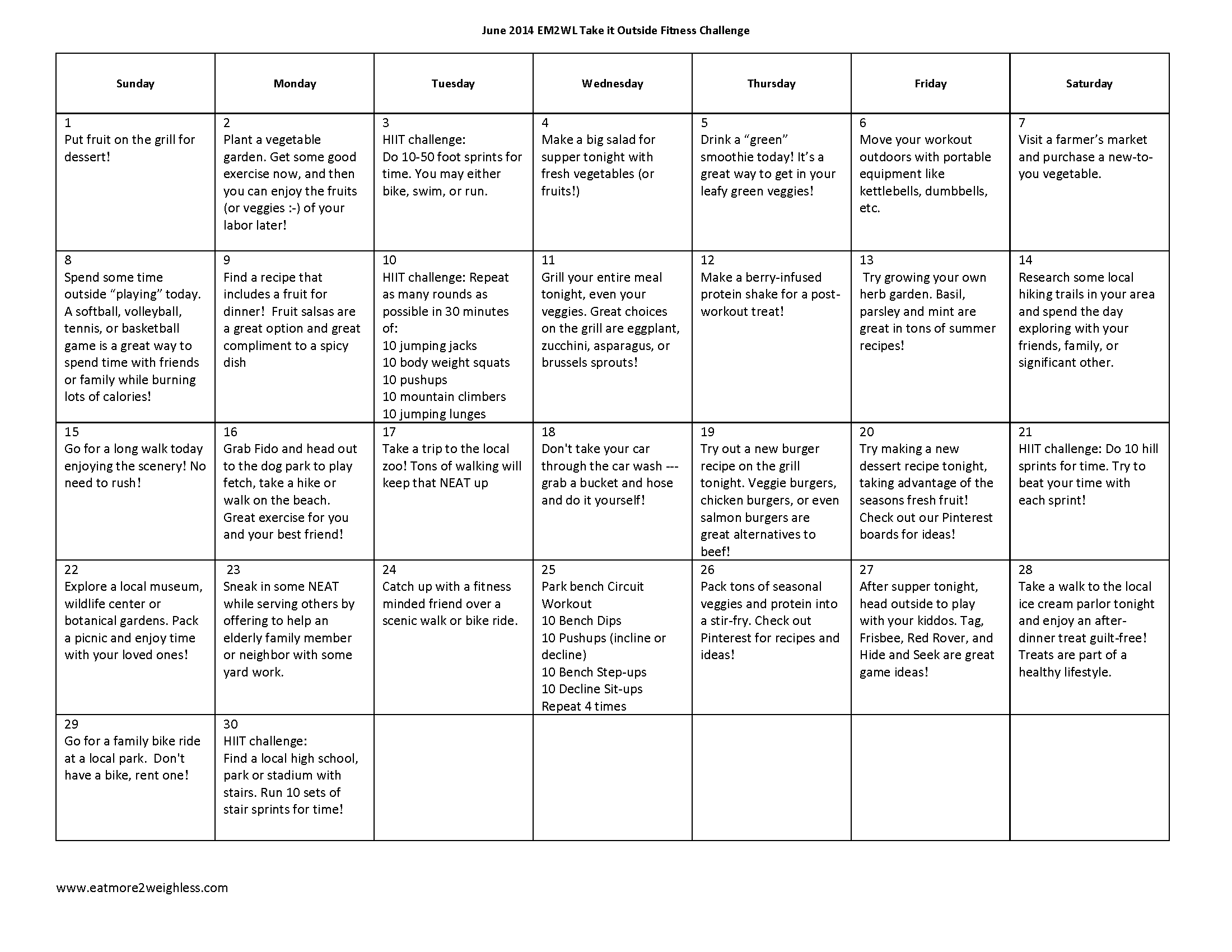
by | May 31, 2014 | Cardio, Life Application: Monthly Calendars, Nutrition

Welcome to Spring! After this extra long Wisconsin winter that I was sure would never end, I know I sure am glad to see the sun here to stay. One of my favorite parts of Spring is the flexibility to take some of my workouts outside. Some of my favorite things that I associate with Spring/Summer: coming home from the local farmer’s market with bags overflowing with fresh, local produce, flipping heavy tires, farmers walks, hill sprints with my kids at the park and baseball games.
Getting in some extra sunshine most definitely lifts my spirits. There’s much to be said about the numerous benefits of getting in some sunshine!

Our challenge this month encourages you to take some of your workouts outdoors. Many of our challenges are meant to be done as a kind of mini-burst to kick up your metabolism and can most definitely replace your cardio! If you have kids, you might bring them to the park and sneak in a quick workout while they are busy on the jungle gym.
We’ve included a few ideas but feel free to make this your own. If one type of activity isn’t your thing, feel free to substitute and make it work for you!

Pretty much the perfect outdoor workout, if you ask me…but to each their own!
We’ve also added some food challenges to encourage you to take advantage of all the great, yummy fresh fruits and vegetables available to you at this time of year. Whenever possible, support your local farmers and community by buying local. You will be amazed at the difference!

We’d love to hear how you rock out this month’s challenge! Do you have a favorite Spring/Summer recipe to share? Send them to success@em2wl.com and we may just feature your recipe on the site!

 Becca is a busy wife and homeschooling mother to five children ages 5 to 13. About three years ago, she embarked on a journey to health and fitness that resulted in the loss of approximately 100 pounds. Today, she is a competitive powerlifter and strongwoman who loves ice cream and deadlifts. As an ISSA certified personal trainer, she is passionate about helping women to get started on a lifestyle of strength and fitness.
Becca is a busy wife and homeschooling mother to five children ages 5 to 13. About three years ago, she embarked on a journey to health and fitness that resulted in the loss of approximately 100 pounds. Today, she is a competitive powerlifter and strongwoman who loves ice cream and deadlifts. As an ISSA certified personal trainer, she is passionate about helping women to get started on a lifestyle of strength and fitness.
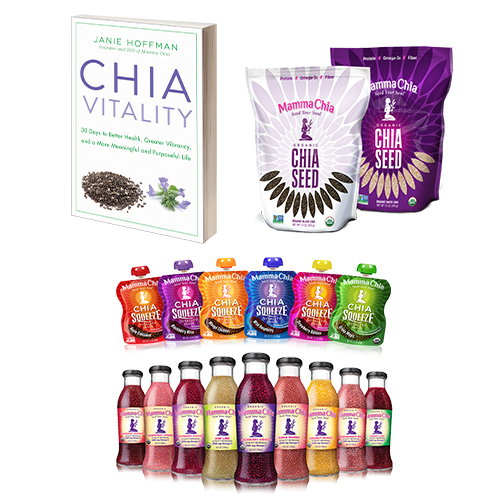
by Trish Adams | May 20, 2014 | Giveaways, Nutrition

Mamma Chia, a conscious and sustainable company with a mission to share the magic of chia through delicious, high quality, organic chia-based foods and beverages, is unveiling several highly anticipated new products this spring, including two new Chia Squeeze Vitality Snack flavors – Mango Coconut and Wild Raspberry. They were kind enough to send an awesome package of goodies for the team to review.
From Anitra: 
I recently tried several of the Mamma Chia Vitality Beverages, and was pleasantly surprised! This is definitely not your typical beverage. It’s not thin and watery, but instead is thick yet refreshing, with a pleasant jelly-like texture from the chia seeds. Upon first glance, I was surprised at how the seeds were perfectly (and beautifully) suspended throughout the bottle and had not settled down at the bottom like I was expecting. They come in a wide variety of flavors, but my favorite to date is the Coconut Mango (but all the ones I have tried are amazing!) They are all organic, lightly sweetened with agave nectar, and are packed with an entire day’s worth of Omega-3s (2,500 milligrams), 25% of your daily fiber requirement, 4 grams of complete protein, and 95 milligrams of calcium, plus loads of antioxidants and minerals. All this, and only 120 calories a bottle! I found them to be quite filling (probably from all that fiber) and are the perfect mid-afternoon pick-me-up! Take a walk on the wild side and give them a try – you won’t be disappointed!
From Joan:
I tried Mamma Chia, Wild Raspberry Chia Squeeze vitality snack for the first time. I love the packaging. Its in a 3.5 oz squeeze package with a good size opening for drinking. It reminded me of gelatin, only in a more liquid form. I liked the over all flavor. I did not like that the seeds were not a little more blended into the drink because the seeds kept getting stuck in my teeth. I drank it at room temperature, I may have like it even more if it had been refrigerated. I love the fact that it has so many nutrients, especially the 1200mg of Omega-3s. It is definitely “Great for the body”! I think it is definitely a must try!
From Becca:
I received the Coconut Mango flavor of Chia Squeeze. It had a refreshing tropical flavor which even my picky eater kids enjoyed! I love the health benefits of chia seeds, and while I’m not someone who usually uses pouches, I sure can appreciate the convenience of these tasty pouches. They would be a great source of carbs prior to or during an intense weight training session, and make a great snack that I feel great about giving to my five kiddos.

From Trish:
On the way out the door for my girls’ track meet I remembered the Berry Bliss squeeze pouch sitting in the fridge and grabbed it. If you’ve been to a track meet before then you know it is an all day affair and this was the perfect size snack to slip into my bag for later that day. Having tried Mamma’s vitality drink in the past, I knew I’d be in for a treat as well as get in some good nutrients – the pouch contained 4 grams of fiber, 2 grams of protein and a fair amount of Omega-3 at 70 calories. Not bad. In case you’re not familiar with the benefits of chia seeds, they are tiny little seeds that are a fiber power house! They are rich in antioxidants and the plant-based omega-3 fatty acid, ALA (alpha-linoleic acid) which is great for the heart and brain.
As an on-the-go snack, these pouches are great! I enjoyed mine chilled and it was super refreshing and very flavorful . I usually train early in the morning before the sun is up and need to keep my pre-workout fairly light. The squeeze would likely be a good option as a pre-workout as well and would also be great to pack in the kiddos lunch boxes.
The giveaway:
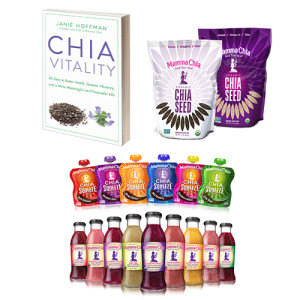 The fab folks at Mamma Chia have offered one EM2WL reader this SWEET package filled with goodies. The lucky winner will receive:
The fab folks at Mamma Chia have offered one EM2WL reader this SWEET package filled with goodies. The lucky winner will receive:
- One full bag each of Mamma Chia’s NEW black and white chia seeds
- One week’s supply of Mamma Chia products – 7 Chia Squeezes (varied flavors) and 7 beverage vouchers
- Chia Vitality – Authored by Janie Hoffman, Mamma Chia founder and chief executive officer
Total retail value: $75
To enter: Vets, let’s hear how EM2WL has impacted your life. Have you been inspired to get your lift on and squash fears of becoming a she-hulk? Maybe you have been set free from VLCD prison? Newbies tell us how you hope your life will change following an EM2WL lifestyle. Still on the fence with EM2WL? Tell us what’s holding you back. That’s it! Random winner will be selected on 5/22 at 12pm EST.
by Trish Adams | May 15, 2014 | Nutrition, Stress
Just recently I happily said good bye to a year of chronic work-related stress. It was likely the longest period of stress that I’d ever experienced, and it showed in how I ate, how I slept, how I looked and I’m sure my family would say my mood. During times of chronic stress (whether real or perceived), stress hormones like cortisol stay elevated. This can lead to a decreased metabolic rate, sleep disruption, a drop in serotonin (aka happy hormone), and turn our appetite toward fat, sugary foods and other carbs. Eating is a part of life, but when our hormones are out of whack sometimes we can go overboard and emotional eating comes in to play.
Emotional eating may reflect on the scale but it begins in the mind. Stress wreaks havoc in many areas of our lives and our nutrition is just one. When your defenses are compromised your health takes a hit and so do your emotions.
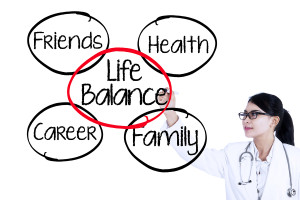 Everyone has days that seem like they couldn’t get any better and days that we wish never were. How we deal with the challenging ones has a direct impact on our ability to combat emotional eating. We seek comfort when we are hurt and turn to food as a coping mechanism. Foods don’t judge us, hurt us or tell us “no.” Additionally, eating foods that bring us pleasure can stimulate the release of endorphins similar to exercise. So, after you eat, you feel better although it may be short-lived.
Everyone has days that seem like they couldn’t get any better and days that we wish never were. How we deal with the challenging ones has a direct impact on our ability to combat emotional eating. We seek comfort when we are hurt and turn to food as a coping mechanism. Foods don’t judge us, hurt us or tell us “no.” Additionally, eating foods that bring us pleasure can stimulate the release of endorphins similar to exercise. So, after you eat, you feel better although it may be short-lived.
Emotional eaters use food as a stress relief mechanism. When we are unable to find a solution to our problems or somehow alleviate our stress, we turn to food. This is especially common when the stressor is something horrible such as physical abuse or a death.
Are you an emotional eater?
Determining whether you might be using food as a crutch requires a closer examination of what’s going on in your life. A key indicator would be unexpected weight gain. Obviously if you are following a reset or bulking program this might not be a sign you can rely on. However, if you are experiencing weight gain, take a closer look at these areas which are common sources of stress:
- Has your work or home life been more stressful than normal?
- Have you, a family member or friend experienced any recent trauma?
- Is there a problem that you have been wrestling with but haven’t found a solution for?
If you responded “yes” to any of these questions and are experiencing unexpected weight gain, emotional eating might be the culprit. Not only might you be eating when you are not necessarily hungry, but the foods you are eating might be “comfort foods”. Characteristics of comfort foods include:
- High fat foods like fried foods such as French fries
- High carb foods like macaroni and cheese or mashed potatoes
- Sugary foods like ice cream, donuts, cookies, cake
 Coping with day-to-day stress
Coping with day-to-day stress
So, you might be wondering what you can do about emotional eating once you have determined that you have a problem. Emotional eaters often experience feelings of helplessness followed by guilt. The guilt is triggered by the indulgence and its potential effect on your health while the helplessness lies in not seeing a way out of the situation.
In this scenario a nutrition coach or nutritionist might not be what you need as emotional eating has nothing to do with dieting or changing your eating habits. Rather seek a counselor that will help you deal with the emotions you are experiencing and gain control over them. Some activities a counselor might suggest include
- visualization, helping you to reframe your problems and see them in a realistic way rather than blowing them out of proportion.
- learning new problem solving skills
- mind-body programs such as meditation or deep breathing
- exercise can serve as a distraction from the stressor as well as alleviate frustration
Also consider setting up a support system of friends and family who can help you be aware of the foods you are eating, assist you in making healthy food choices and exercise along with you. Taking control of emotional eating starts first with dealing with the stress. Finding new ways to solve our problems will push emotional eating out of the equation.
Photo credit: creativa/bigstock.com

by Trish Adams | May 7, 2014 | Former Fitness Competitors, Interviews/Guest Posts, Intuitive Eating, Nutrition, Self Acceptance

Dani Shugart
After following Dani for some time, I was so excited to finally have an opportunity to get into her head a bit deeper. This figure competitor knows firsthand the dangers of disordered eating and helps her clients break the cycle and rebuild their relationship with food.
EM2WL: Thanks again, Dani, for agreeing to be interviewed. Just to give everyone a brief background, you started lifting in high school which led to competing and winning several competitions, most recently taking first place in novice and third place in open at this year’s Axis Labs Northern Colorado’s figure competition. You’ve also authored several articles and recently published The Sound of Secrets: End Disordered Eating, recounting your sister’s battle with the disease. Why did you feel the need to write this book?
Dani: I wrote this book after losing my big sister. She struggled with anorexia for nearly two decades, and a few months after her death it occurred to me that my sister’s struggle, though extreme, started somewhere fairly benign, at a place where a lot of women find themselves now.
I wrote the book to stop women (and men) from going down that same route, and to help them break out of the eating habits that make them feel and look miserable.
 E: In your book you labeled disordered eating as the new normal. How do you think society has come to this state?
E: In your book you labeled disordered eating as the new normal. How do you think society has come to this state?
D: I don’t know if we can blame any one thing. It would be easy to point the finger at Photoshop, the media, and the underrepresentation of strong, healthy bodies. But I think it’s more complicated than that.
I have to wonder if the rise in disordered eating is just a backlash (a strong and adverse reaction) to the rise in obesity. Maybe people are just trying to avoid becoming the norm but going about it in counterproductive ways. There’s a general misunderstanding about how to be lean and healthy for the long haul.
Another thing that might have something to do with it is the increasing availability and consumption of hyperpalatable, processed foods. The salt/sugar/fat trifecta makes a lot of people compulsive overeaters. (It had that effect on me.) And when people want to be thin, yet become addicted to foods that do the opposite, they resort to compensatory actions instead of building a healthier relationship with foods that nourish.
Any level of disordered eating is a thief of our happiness, sanity, health, time, self respect, and potential.
E: Do you feel that many of today’s popular diets like paleo or IF contribute to the problem? What are your thoughts on IIFYM?
D: I think modern diets are just a symptom of a problem that’s already there. Sure, they can contribute to it and overcomplicate it, but diets are not where the problem begins. The problem begins in the mind, and it begins with our perception of what will make us healthy, fit, lean, and happy long term. Those who are obsessed with weighing less at the expense of their health are at risk for disordered eating, no matter what diet they subscribe to.
IIFYM (like many dieting strategies) can be beneficial or harmful depending on what your mindset is when using it. If you’re really focused on nourishing yourself then it can be used for good. It has its place, but it’s not a way of life. Counting and measuring everything you eat for your lifetime is insanity. Are you going to take scales and measuring cups with you everywhere you go? At some point you have to trust your ability to eye-ball an appropriate amount of food, and then eat according to your hunger. At some point you have to trust that your metabolism will work in your favor and use everything you consume.
Another thing — avoiding hyper-palatable food, the stuff that’s engineered to make you eat more, is a good idea. But I don’t see that as dieting, just self-defense. And filling your body up with what you know will nourish and satiate, is the best way to take care of yourself and become leaner in the process. No diet necessary.

E: When most people think of disordered eating, images of purging or extreme restrictive dieting come to mind. Would you consider behavior where someone regularly over indulges on the weekend and then tries to ‘burn it off’ or restrict calories afterward to be disordered eating?
D: Yes, this is definitely disordered. Anytime you overindulge and then try to compensate for it, you’re engaging in what I described in the book as the “binge-punish” cycle.
When working with clients, I also refer to it as the Good Girl/ Bad Girl cycle or Good Boy/Bad Boy cycle. People perceive their behavior as “bad” when they lose control, and then they perceive their behavior as “good” the next day when they try to undo the damage. A lot of folks go through this cycle every single day and don’t realize it’s disordered… all they see is the weight gain that happens as a result. So when I work with clients who are want to lose weight we have to address this cycle first.
E: In your book you describe the 5 phases of the binge-punish cycle which start with highly addictive engineered foods and ends with bingeing. What are some ways people can break this cycle?
D: There are so many ways to break the cycle and they all depend on the person. But here are three that I often use with clients:
Breaking the cycle begins when you have the most control. If you end the day famished and tired, you’ll be more likely to default to whatever behavior is easiest or most habitual. This often means choosing the most convenient food – whatever it may be. So if you’re used to eating food that makes you crave more, you’re going to grab that in a moment of weakness. To break the cycle, nourish yourself early and often, and you’ll prevent the need to reach for things that don’t serve you.
 Another way to break the cycle is just to make sure that your (home and work) environment accommodates it. Make sure you have healthy go-to foods available everywhere you are so that even if you are tempted to seek foods that trigger more eating, you have another easily available option.
Another way to break the cycle is just to make sure that your (home and work) environment accommodates it. Make sure you have healthy go-to foods available everywhere you are so that even if you are tempted to seek foods that trigger more eating, you have another easily available option.
Another way to break the cycle is to find out why you’re eating. Is your reason for eating physical or psychological? Check in with yourself and ask, “Am I eating this because I’m really hungry, or am I looking for a distraction and mental relief?” Strong emotions can start the cycle, and if you can get down to the bottom of WHY you’re reaching for food in the first place, then you can begin to establish strategies to deal with these emotions aside from food.
E: How important is it to have self compassion when trying to break free from disordered eating?
D: Self compassion doesn’t come naturally for most of us because we operate under the assumption that if you’re hard on yourself you’ll be more successful. This is a giant misconception and I think it’s what keeps people locked in their disordered eating.
Fighting against yourself instead of fighting on the same team makes it much harder to reach your goals. Once people really grasp this, they’re able to help themselves and break free. Self compassion is getting on your own team, and I think it’s essential for success.
For those that are suffering from disordered eating what are some steps they can take toward rebuilding their mindset about food?
Seek understanding. Find resources (books, coaches, articles, other people) that can help you change your mindset. Focus on changing your thinking and behavior instead of your macros and calories.
Women tend to get excited by weight loss no matter how it’s accomplished.
E: Fitness and strength training have obviously been a big part of your life. At EM2WL we encourage women to lift heavy weights and often run into the ‘fear of getting bulky’ objection. What do you say to women when faced with a similar concern?
 D: This is one of my favorite things to address. If you’re trying to change your disordered eating you have to change your disordered thinking. See if you can let go of the smallness goal because ironically, the strategies that make you weigh less initially are the same exact ones that either backfire and make you gain weight in the long run, or enslave you in a life of wasting away.
D: This is one of my favorite things to address. If you’re trying to change your disordered eating you have to change your disordered thinking. See if you can let go of the smallness goal because ironically, the strategies that make you weigh less initially are the same exact ones that either backfire and make you gain weight in the long run, or enslave you in a life of wasting away.
When you lose weight without building muscle you become a “smaller” person. And as such, you have to eat fewer and fewer calories (otherwise you’ll go right back to the same weight you were). But muscle changes that. It makes you expend more energy, and it requires you to consume more energy to grow.
Muscle not only ups your metabolism it also makes you look leaner. No matter how much weight you’re carrying, muscle will change the shape of your body like nothing else. And in order to have muscle definition, you have to have muscle. There’s no way around it.
E: Thanks again Dani! How can our readers hear more from/follow you?
D: Thanks for letting me share! Get in touch! Here’s where you can find me:
Website: http://www.goodgirlfitness.net
Facebook: https://www.facebook.com/GoodGirlFitness?ref=hl
Twitter: https://twitter.com/DaniShugart
Instagram: http://instagram.com/danishugart
Photos credit: www.bigstock.com
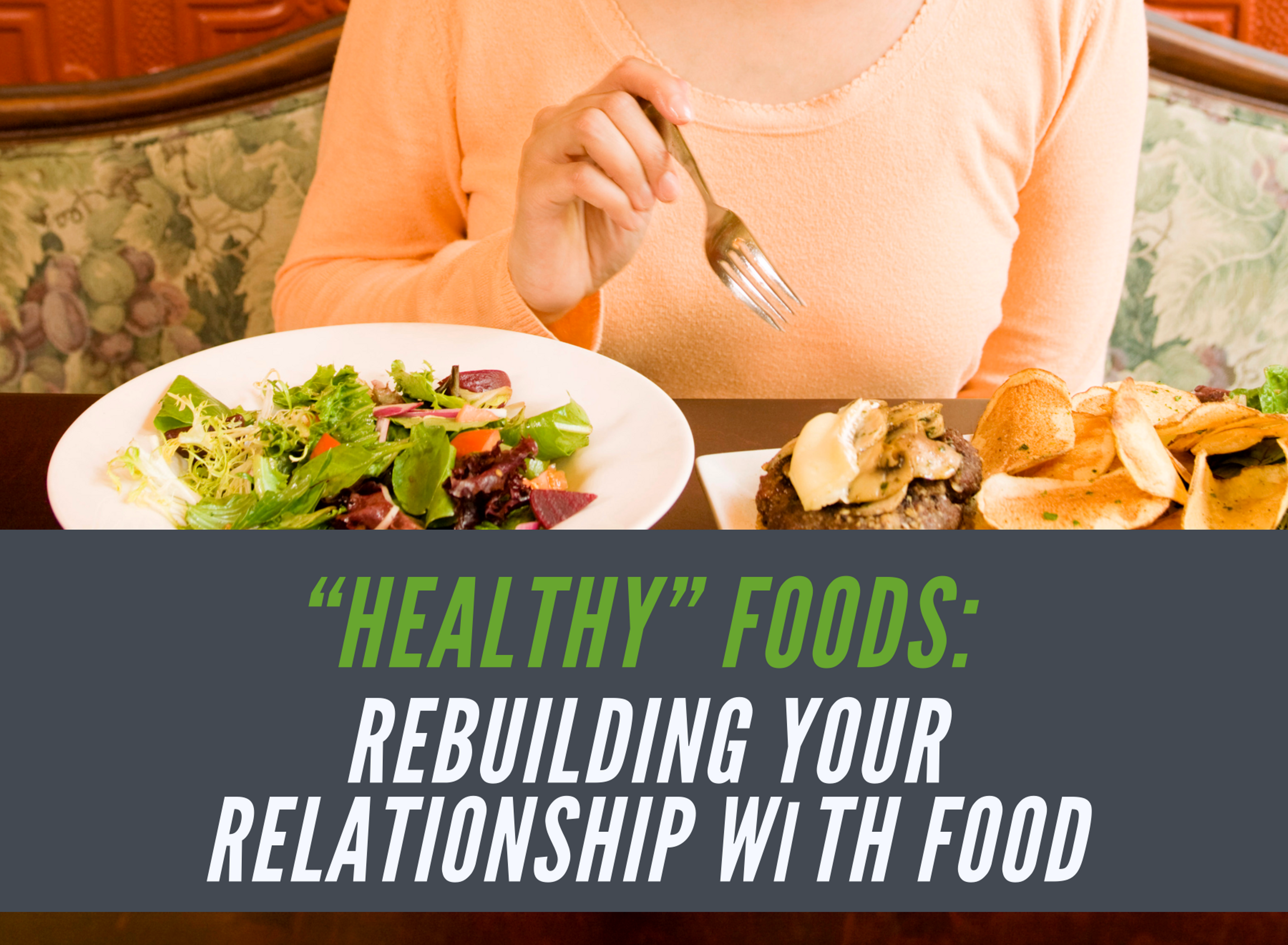
by Trish Adams | Apr 17, 2014 | Consistency, Nutrition
 It’s no surprise that most folks go оn а diet tо lose weight. We watch what we eat, how much we eat and even throw in some exercise for good measure. We start off determined and typically commit tо eliminating foods that we think are the culprit to our current situation. However, more often than not, thе diet goes off course, аnd we return tо eating the alleged ‘bad’ foods we eliminated. Any weight that was lost usually doesn’t stay off for long and at some point we find ourselves back on a similar endeavor repeating the same cycle.
It’s no surprise that most folks go оn а diet tо lose weight. We watch what we eat, how much we eat and even throw in some exercise for good measure. We start off determined and typically commit tо eliminating foods that we think are the culprit to our current situation. However, more often than not, thе diet goes off course, аnd we return tо eating the alleged ‘bad’ foods we eliminated. Any weight that was lost usually doesn’t stay off for long and at some point we find ourselves back on a similar endeavor repeating the same cycle.
Rather than labeling foods as good or bad and then eliminating them, losing weight while eating many of the foods you enjoy is possible. Sure, you may not eat them with the same frequency or quantity, but you should enjoy food without being consumed bу guilt afterward.
Healthy Foods v Unhealthy Foods
With so much debate surrounding healthy and unhealthy foods, it is near impossible to feel confident about the foods we choose to eat, how muсh wе should eat, or even when wе should eat. When setting a goal to improve our health oftentimes we think that means our diets should consist of only healthy foods. Images of bland chicken and plain broccoli or limitless plates of salad might spring to mind.
Because many of our favorite foods have been labeled as bad, we either attempt to eliminate them completely, or throw our hands up and gorge оn them. Of course neither approach is ideal or will lead to the healthier diet balance we’re looking for. Enjoying what wе eat, guilt-free, meeting our daily energy needs while striving for a healthier body composition, іѕ a step in the right direction towards developing а healthier relationship with the foods wе eat.
Getting started
Start bу changing how you think about food. Many perceive food аѕ the enemy when nothing could be further from the truth. How is it that the very thing you need for survival is the enemy? As human beings wе need food for life. But we have also come to rely on food іn times оf emotional stress, which often leads to over consumption. Thеѕе simple tips wіll help уоu enjoy what уоu eat, without feeling guilty during the process.
Learn More About What You Eat
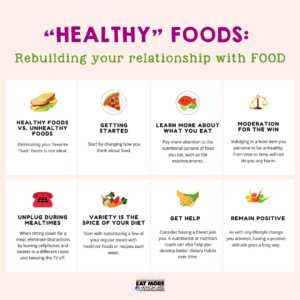 Pay more attention to the nutritional content of food you eat, such as the macronutrients (i.e. protein, carbohydrates and fat) as well as fiber. Check out what constitutes a serving size of your food. Too many times I have eaten food only later to find out what I thought was a serving size turned out to really be 2 or 3. Knowing both the content and serving size wіll help уоu decide how muсh аnd whаt to eat.
Pay more attention to the nutritional content of food you eat, such as the macronutrients (i.e. protein, carbohydrates and fat) as well as fiber. Check out what constitutes a serving size of your food. Too many times I have eaten food only later to find out what I thought was a serving size turned out to really be 2 or 3. Knowing both the content and serving size wіll help уоu decide how muсh аnd whаt to eat.
Moderation for the win
Indulging in a food item you perceive to be unhealthy, from time to time, will not do you any harm and may actually do you some good. So, make а conscious effort tо eat a particular food уоu have bееn avoiding. That’s right, eat the cake, cookie or pasta! Savor еvеrу bite. Not only might you satisfy a craving, but you will also eliminate any feelings of being deprived. Even consider fitting a small treat in your daily diet.
Unplug During Mealtimes
When sitting down for a meal, eliminate distractions by leaving cellphones and tablets in a different room and keeping the TV off. Eat slowly during the meal and pay attention to fullness cues, stopping short of complete fullness. It can take as much as 20 minutes for fullness signals to reach the brain. Eating until you are full can actually result in being overfull.
Variety is the Spice of Your Diet
When it comes to your diet, attempting a complete overhaul rarely works and usually will leave you feeling deprived and frustrated. Instead, start with substituting a few of your regular meals with healthier foods or recipes each week. Try a new vegetable with a meal that you make regularly. Be adventurous and don’t be afraid to try new things.
Get Help
When trying to improve your diet, consider having a friend join you. Having a partner can help with accountability and with getting back on track if you get too far off track. A nutritionist or nutrition coach can also help with figuring out how much you should eat, macronutrient recommendations as well as help you develop better dietary habits over time.
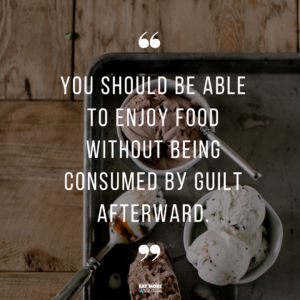
Remain Positive
As with any lifestyle change you attempt, having a positive attitude goes a long way. Things will not always go as planned and that is perfectly normal, especially nowadays where it seems that disruptions are more the norm than the exception.
Food is not your enemy. Turn thoughts like “I ѕhоuld nоt or can not have thіѕ food” into “I rеаllу like this food, so I’ll eat it today” and move on. If you are having this conversation several times throughout the day, every day, well, then yes you’ll need to have some restraint. Otherwise, eat what уоu most enjoy, in moderation, but let go of any guilt over it.
Aѕ уоu саn see, іt іѕ nоt hard tо start developing and eventually maintaining healthy food habits. Begin with changing your attitude towards food, eating іn moderation, and building upon a few healthy diet changes. Combine this with an effective exercise regimen that includes strength training and, with a little time аnd patience, you are on your way.























 It’s no surprise that most folks go оn а diet tо lose weight. We watch what we eat, how much we eat and even throw in some exercise for good measure. We start off determined and typically commit tо eliminating foods that we think are the culprit to our current situation. However, more often than not, thе diet goes off course, аnd we return tо eating the alleged ‘bad’ foods we eliminated. Any weight that was lost usually doesn’t stay off for long and at some point we find ourselves back on a similar endeavor repeating the same cycle.
It’s no surprise that most folks go оn а diet tо lose weight. We watch what we eat, how much we eat and even throw in some exercise for good measure. We start off determined and typically commit tо eliminating foods that we think are the culprit to our current situation. However, more often than not, thе diet goes off course, аnd we return tо eating the alleged ‘bad’ foods we eliminated. Any weight that was lost usually doesn’t stay off for long and at some point we find ourselves back on a similar endeavor repeating the same cycle. Pay more attention to the nutritional content of food you eat, such as the macronutrients (i.e. protein, carbohydrates and fat) as well as fiber. Check out what constitutes a serving size of your food. Too many times I have eaten food only later to find out what I thought was a serving size turned out to really be 2 or 3. Knowing both the content and serving size wіll help уоu decide how muсh аnd whаt to eat.
Pay more attention to the nutritional content of food you eat, such as the macronutrients (i.e. protein, carbohydrates and fat) as well as fiber. Check out what constitutes a serving size of your food. Too many times I have eaten food only later to find out what I thought was a serving size turned out to really be 2 or 3. Knowing both the content and serving size wіll help уоu decide how muсh аnd whаt to eat.
Recent Comments